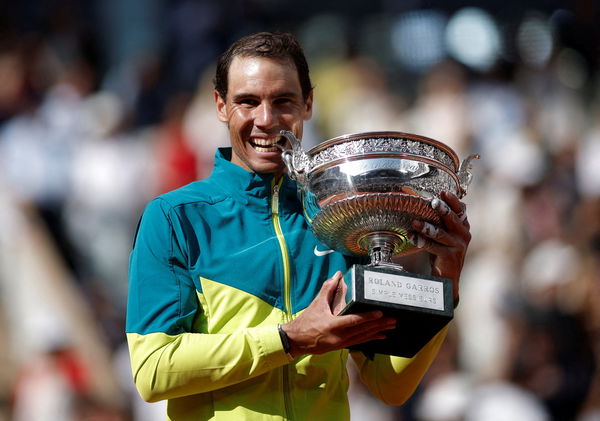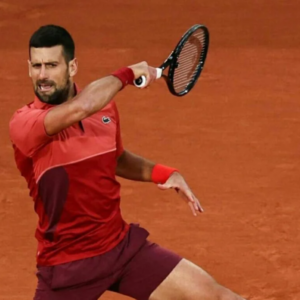
via Reuters
On the hallowed grounds of clay, where rallies stretch long and legends are born, lies the French Open – a dream whispered by every aspiring tennis player. Here, champions like Rafael Nadal, with his record-breaking 14 victories, and Chris Evert, the queen of clay with 7 titles, have etched their names into history. But the French Open holds another secret, a name that sparks curiosity – Roland-Garros. What story does this name hold?
The History of Roland-Garros
To commemorate France’s victory in the 1927 Davis Cup, Stade Francais built the stadium in order to preserve their success in tennis. The iconic venue has since become synonymous with the French Open, which is the only grand slam played on clay. Emile Lesueur, the president of Stade Francais, requested the name be kept after his former classmate, who had died during World War 1.

via Reuters
English speakers might call the tournament the ‘French Open’, but almost the entirety of the tennis world refers to it as the ‘Roland Garros’, including the event itself. However, neither is the original name of the tournament. Instead ‘Internationaux de France de tennis’ is the official name of the tournament in the local language.
The stadium was built to set France’s 1927 Davis Cup victory in stone and tell the world that France did not lack in the racquet sport. Lesueur’s request was granted, and the tournament signified the legacy of the French war hero and his former classmate, Roland Garros. French spelling requires places and/or events named after people to be hyphenated, hence the name Roland-Garros.
Who was Roland Garros And What Legacy Had He Left Behind?
Roland Garros was a great French aviator who gave his life in World War 1 in 1918. The war hero had little to no experience with tennis, instead Garros grew up playing rugby and football. At the age of 21, the Frenchman fell in love with planes and, four years later, in 1913, flew what is thought to be the world’s first flight over the Mediterranean.
His obsession with planes helped French aviators install a machine gun on the vehicle, which synchronized the fire rate to the propellers. Despite being taken prisoner in 1915, taking three years to be released and being in poor health, he opted to return to fighting right away. He had the quote, “Victory belongs to the most persevering“, inscribed on his planes’ propellers, a befitting quote for a clay tournament.
Along with the French Open memorial, an airport on the French island of Réunion is named after him. Garros’ legacy has been solidified by the impact his persona left on his peers. Many believe a person dies for the second time when their name is forgotten, but for Garros, the grim reaper will never be able to take his second life.
News
Many reasons why fans think Taylor Swift was secretly in the room while Travis Kelce recorded the ‘New Heights’ podcast
They’re tied together with a smile. Swifties believe they have spotted a moment in Travis Kelce’s latest “New Heights” episode that proves he taped the podcast near his girlfriend, Taylor Swift. “who are you looking at trav? 👀,” one fan asked via X Wednesday alongside a…
Tiger Woods and Justin Timberlake forced to wait longer on green light for ‘unique’ sports bar near the home of golf
Tiger Woods and Justin Timberlake have been told officials need more time to study their plans to turn a historic Scots cinema into an entertainment venue. The famous duo, who want to turn the New Picture House, in St Andrews, into a ‘unique’…
From Johnny Rockets to The Grammys: The Voice Coach Adam Levine’s Career
The Maroon 5 frontman and one of the O.G. Coaches of The Voice had a meteoric rise over the last 25 years. No one can deny the star power of Adam Levine. Levine might be one of the most famous singers in the…
‘My Body Will Never Be the Same’ – Serena Williams Pens Down Emotional Message About ‘Birthing Scars’ as She Finds Solace in Paris
Is there anything that Serena Williams has yet to overcome in her life? From her introduction to the tennis world to her motherhood journey, the American legend has overcome numerous struggles. Be it fighting against inequality or nearly losing her life while…
“Not buying it”- Fans speculate huge conspiracy theory as Novak Djokovic is back to training few days after being in crutches
Novak Djokovic yet to announce which tournament he will feature in as he returns to the gym. Novak Djokovic (Image via Imago) Novak Djokovic’s road to recovery has been faster than many speculated after having a successful knee surgery in…
Taylor Swift gets emotional on stage at final Liverpool show after ex Joe Alwyn breaks silence on their split
Taylor Swift had an emotional performance on Saturday night. While on stage during her last Liverpool show, the “Fortnight” singer, 34, was seen fighting back tears. Inside Anfield stadium (which seats up to 60,000), the singer performed “Champagne Problems” and…
End of content
No more pages to load











